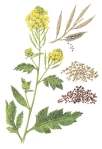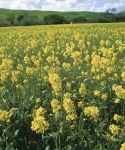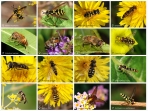Click pictures to Zoom In
 No herb garden or kitchen should be without a supply of garden fresh Mustard. Mustard is an ancient plant that’s full of appeal for contemporary gardeners. Historical records indicate the use of mustard as far back as 4,000 b.c.e., and it’s believed prehistoric man chewed mustard seeds with his meat from about 2,000 b.c.e. on, ancient civilizations used it as an oil, a spice, and a medicinal plant. It was introduced into western and northern Europe in the early Middle Ages.
No herb garden or kitchen should be without a supply of garden fresh Mustard. Mustard is an ancient plant that’s full of appeal for contemporary gardeners. Historical records indicate the use of mustard as far back as 4,000 b.c.e., and it’s believed prehistoric man chewed mustard seeds with his meat from about 2,000 b.c.e. on, ancient civilizations used it as an oil, a spice, and a medicinal plant. It was introduced into western and northern Europe in the early Middle Ages.
Mustard has been imbued with curative powers. It’s been used as an appetite stimulant, a digestive aid, and a decongestant. Because mustard increases blood circulation, it’s often used in plaster form to treat inflammation. Folklore has it you can even sprinkle mustard powder in your socks to prevent frostbite.
Mustard varieties produce black, white, and brown seeds, respectively. The black seeds are used for moderately spicy mustard’s. In West Indian dishes, black seeds are fried until they pop. The black variety produces less desirable greens, and is really intended to be grown only for seed. French cooks use them to make Dijon style mustard.
White mustard seeds are the primary ingredient in traditional American style ball park mustard, and it’s the most common and the mildest of the three. The white seeds also have the strongest preserving power and are therefore the kitchen gardener’s choice for pickles, relishes, and chutneys. White mustard’s are not typically grown for their greens.
Brown mustard, the hottest of all, is used for curries and Chinese hot mustard’s, and frequently for Dijon type mustard’s. If you’re growing mustard for the greens, choose a brown variety or an Oriental variety like ‘Red Giant’.
 The plants are easy to grow and produce seed in as few as 60 days. Shoots, leaves, flowers, whole seed, powdered, or prepared is a flavorful, low fat way to punch up any savory food.
The plants are easy to grow and produce seed in as few as 60 days. Shoots, leaves, flowers, whole seed, powdered, or prepared is a flavorful, low fat way to punch up any savory food.
Used the whole seed in pickling and cooking, tossed the tender greens in fresh salads (garnish using mustard flowers), stewed mature leaves as a southern style side dish, and crushed spicy seed to make a variety of pungent mustard’s.
Mustard seed contains no cholesterol, only trace amounts of vegetable fat, and about 25 percent protein. Leaf mustard contains calcium, phosphorus, magnesium, and Vitamin B. The calories are negligible in most basic prepared mustards, so feel free to indulge yourself.
Mustard will grow well in most soils, but will produce the most seed in rich, well drained, well prepared soil. It will thrive if given constant moisture. It likes cool weather, a light frost can even improve the flavor. Black mustard is the least fussy of the three mustard types. For best results, add a little 5-10-10 fertilizer or the organic equivalent. Thoroughly work the amendments into the top 2 to 3 inches of soil just prior to seeding. Mustard is blissfully free of insect and disease problems, and larger critters don’t seem to like it much either. The hotter and drier the weather, though, the faster the plants go to seed, in as little as 30 to 60 days, depending on the variety and the climate.
Pick leaves for salad when they’re small, young, and tender, or use the larger leaves for sautéing or stewing. Add young leaves to stir fries and salads. Mustard greens add a nice, sharp flavor contrast to mild, buttery lettuces.
Larger mustard leaves need to be cooked. Stew them with bacon or a ham hock, southern style, or shred and sauté them with other greens to make a bed for grilled fish and meats. You can also add mustard greens to long-cooking soups and stews.
Flowers can be used as an edible garnish.
Hint Here are a few things to keep in mind when working with mustard. About ten mustard flowers yield 1⁄4 cup seeds, which in turn yields 1 cup prepared mustard, two or three plants will provide you with this.
Caution Vinegar and the acidic component of mustard will react with aluminum bowls and utensils, giving mustard a metallic taste.
Be sure to use wooden spoons and stainless steel or glass or ceramic coated pans, and always store mustard in glass or ceramic containers.
Some of the good guy’s Syrphid fly, hover fly, flower fly, is a large group of medium to large flies, ranging from 1/4 to 3/4 inch long. Most adult hover flies are black or brown with yellow banded abdomens and body markings, superficially resembling bees and wasps except that they have only two wings that are not held over the back of the body when at rest.
In general, females lay single white eggs on leaves near aphid infestations Larvae or maggots hatch from eggs in about 3 days. Adults emerge in one to two weeks unless the pupal stage remains through the winter. Up to seven generations occur annually.
If you see or read something you like Please Share By Emailing It To A Friend.
Not from the USA. Please leave me comment about your home town and country.
Why is common sense so uncommon?
Don’t be Shy. Leave me your Comment(s)


So mustard is a plant. I keep think they grow into trees, ignorant me! The yellow flowering field looks lovely.
LikeLike
Not ‘ignorant’ as with many plants, you had no reason to know if mustard grows 18 inches or 18 feet tall.
Happy Safe Easter
LikeLike
Mustard is a great plant! Very tasty in so many forms.
LikeLike
I think you convinced me to try growing some mustard. Thanks!
LikeLike